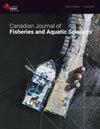综合水声和遥测测量估算鱼类丰度:解决老问题的新方法
IF 2.2
2区 农林科学
Q2 FISHERIES
Canadian Journal of Fisheries and Aquatic Sciences
Pub Date : 2023-06-13
DOI:10.1139/cjfas-2022-0183
引用次数: 0
摘要
种群丰度是渔业和自然保护的一个关键指标,但很难准确测量。现有的估计方法面临着重大挑战:标记再捕获方法耗时耗力,水声回波计数方法面临着目标识别和栖息地类型的问题,而这些问题是它们可以有效应用的。我们提出了一种新的丰度估计方法,可以提高回波计数方法的可靠性。劈开波束水声测量数据与携带声学应答器标签的鱼类遥测数据相结合。这些标签通过空间和时间同步的多波束声学测量来计数,以产生标记再捕获丰度估计。我们对4个野生湖鳟鱼种群进行了评估,数量从200到3000不等。我们的丰度估计与传统Schnabel和Jolly-Seber标记-再捕获研究的结果一致。我们表明,这种方法在一年的野外工作中所达到的精度可以与长期(10年)连续的标记重新捕获研究相媲美。我们还讨论了可以用这种方法解决的其他生态问题。本文章由计算机程序翻译,如有差异,请以英文原文为准。
Integrating Hydro-acoustic and Telemetry Surveys to Estimate Fish Abundance: A New Approach to an Old Problem
Population abundance is a critical metric in fisheries and conservation but it is difficult to measure accurately. Existing estimation methods present significant challenges: mark-recapture methods are time- and labour-intensive, and hydroacoustic echo counting methods face issues with target identity and the habitat types where they can be effectively applied. We present a new methodology for abundance estimation that can improve the reliability of echo counting methods. Split beam hydroacoustic survey data is integrated with telemetry data from fish bearing acoustic transponder tags. These tags are counted by a spatially and temporally concurrent multibeam acoustic survey to produce mark-recapture abundance estimates. We assessed this approach on four wild lake trout populations, ranging in abundance from ~ 200 to ~ 3000 adults. Our abundance estimates were consistent with those derived from conventional Schnabel and Jolly-Seber mark-recapture studies. We show that the precision achievable with this method in one year of field work rivals that provided by long term (> 10 years), continuous mark-recapture studies. We also discuss other ecological questions that could be addressed with this approach.
求助全文
通过发布文献求助,成功后即可免费获取论文全文。
去求助
来源期刊

Canadian Journal of Fisheries and Aquatic Sciences
农林科学-海洋与淡水生物学
CiteScore
4.60
自引率
12.50%
发文量
148
审稿时长
6-16 weeks
期刊介绍:
The Canadian Journal of Fisheries and Aquatic Sciences is the primary publishing vehicle for the multidisciplinary field of aquatic sciences. It publishes perspectives (syntheses, critiques, and re-evaluations), discussions (comments and replies), articles, and rapid communications, relating to current research on -omics, cells, organisms, populations, ecosystems, or processes that affect aquatic systems. The journal seeks to amplify, modify, question, or redirect accumulated knowledge in the field of fisheries and aquatic science.
 求助内容:
求助内容: 应助结果提醒方式:
应助结果提醒方式:


